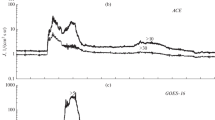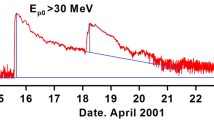Abstract—
The paper presents the results of studying two solar proton events—on March 7, 2011, and on February 20, 2014—which are associated with solar flares having almost the same power and located at close heliolongitudes, on the western side of the solar disk. The work was done on the basis of the experimental data obtained from the ACE spacecraft and the GOES artificial Earth satellites, located in the interplanetary space at the L1 point and inside the Earth’s magnetosphere on the geostationary orbit, respectively. A comparative analysis of the features of time profiles of solar energetic proton fluxes and variations of the interplanetary medium parameters is carried out. These parameters included the speed and density of the solar wind and the magnitude and direction of the interplanetary magnetic field. The main distinctions in the time profiles of proton fluxes of two solar events are shown to be related with the features of the interplanetary medium state on March 7, 2011, and on February 20, 2014. The results of a comparative analysis of time variations of solar proton fluxes with E > 10 and E > 30 MeV and of the Bz- and Bx-components of the interplanetary magnetic field on February 20, 2014, testify to the determining role of the interplanetary magnetic field’s structure in the formation of the features of time profiles of particle fluxes in the given event.





Similar content being viewed by others
REFERENCES
Vernov, S.N., Tverskoi, B.A., Lyubimov, G.P., et al., Cosmic-ray intensity variations and solar wind, Izv. Akad. Nauk SSSR. Ser. Fiz., 1975, vol. 39, no. 2, pp. 340–349.
Lyubimov, G.P., Diagnostic technique for studying the interplanetary magnetic field, solar wind plasma and their sources on the Sun, Izv. Akad. Nauk SSSR. Ser. Fiz., 2003, vol. 67, no. 3, pp. 353–366.
Tverskaya, L.V., Diagnostics of the magnetosphere based on the outer belt relativistic electrons and penetration of solar protons: A review, Geomagn. Aeron., 2011, vol. 51, no 1. pp. 8–24.
Forbush, S.E., Three unusual cosmic-ray increases possibly due to charged particles from the Sun, Phys. Rev., 1946, vol. 70, p. 771. https://doi.org/10.1103/PhysRev.70.771
Lee, M.A., Coupled hydromagnetic wave excitation and ion acceleration at an evolving coronal/interplanetary shock, Astrophys. J. Suppl. Ser., 2005, vol. 158, pp. 38–67.
Reames, D.V., Magnetic topology of impulsive and gradual solar energetic particle events, Astrophys. J., 2002, vol. 571, pp. L63–L66.
Laurenza, M., Consolini, G., Storini, M., et al., On the spectral shape of SEP events: an extreme value statistics approach, Proc. AIP Conf., 2013, vol. 1539, pp. 219–222. https://doi.org/10.1063/1.4811027
Bazilevskaya, G.A., Once again about origin of the solar cosmic rays, J. Phys.: Conf. Ser., 2017, vol. 798, p. 012034. https://doi.org/10.1088/1742-6596/798/1/012034
Miroshnichenko, L.I., Solar cosmic rays: 75 years of research, Phys. Usp., 2018, vol. 61, no. 4, pp. 323–352.
Parker, E.N., Interplanetary Dynamical Processes, Geneva: Interscience, 1963.
Lyubimov, G.P., Pulling out magnetic loops in the solar atmosphere, Astron. Tsirkulyar Akad. Nauk SSSR, 1986, no. 1441, pp. 5–6.
Lyubimov, G.P., Ascending flows in the solar atmosphere and formation of the solar wind, Cosmic Res., 2006, vol. 44, no. 2, pp. 111–127.
Lyubimov, G.P. and Shcherbovskii, B.Ya., Determination of typical dimensions of the IMF solar wind tube structures on September 8, 1973, using the data of the Mars-7 automatic interplanetary station, Cosmic Res., 2003, vol. 41, no. 5, pp. 517–520.
Lyubimov, G.P., Local radiation belts of the Sun, Cosmic Res., 2002, vol. 40, no. 6, pp. 565–570.
Burkholder, B.L., Otto, A., Delamere, P.A., et al., Magnetic connectivity in the corona as a source of structure in the solar wind, J. Geophys. Res.: Space Phys., 2019, vol. 124, pp. 32–49. https://doi.org/10.1029/2018JA026132
Miroshnichenko, L.I. and Petrov, V.M., Dinamika radiatsionnykh uslovii v kosmose (Dynamics of Radiation Conditions in Space), Moscow: Energoatomizdat, 1985.
Bütikofer, R., Flückiger, E.O., Desorgher, L., et al., The extreme solar cosmic ray particle event on 20 January 2005 and its influence on the radiation dose rate at aircraft altitude, Sci. Total Environ., 2008, vol. 391, nos. 2–3, pp. 177–183. https://doi.org/10.1016/j.scitotenv.2007.10.021
Dorman, L.I. and Miroshnichenko, L.I., Solnechnye kosmicheskie luchi (Solar Cosmic Rays) Moscow: Fizmatgiz, 1968.
Reames, D.V., Ng, C.K., and Berdichevsky, D., Angular distributions of solar energetic particles, Astrophys. J., 2001, vol. 550, pp. 1064–1074.
Lupton, J.E. and Stone, E.C., Solar flare particle propagation: Comparison of a new analytic solution with spacecraft measurements, J. Geophys. Res., 1973, vol. 78, no. 7, pp. 1007–1018. https://doi.org/10.1029/JA078i007p01007
Lyubimov, G.P., Reflective model of SCR motion in loop traps, Astron. Tsirkulyar Akad. Nauk SSSR, 1988, no. 1531, pp. 19–20.
Leske, R.A., Christian, E.R., Cohen, C.M.S., et al., Observations of the 2019 April 4 solar energetic particle event at the Parker Solar Probe, Astrophys. J. Suppl. Ser., 2020, vol. 246, no. 2, id. 35. https://doi.org/10.3847/1538-4365/ab5712
Lyubimov, G.P. and Grigorenko, E.E., The reflection model for propagation of solar cosmic rays, Cosmic Res., 2007, vol. 45, no. 1, pp. 9–15.
Tulupov, V.I., Grigorenko, E.E., Vlasova, N.A., et al., Motion and transport of solar cosmic rays in heliospheric traps: The event on January 28–31, 2001, Cosmic Res., 2012, vol. 50, no. 6, pp. 397–404.
Daibog, E.I., Kecskeméty, K., Lazutin, L.L., et al., A 27-Day Period in the Flux of Jovian Electrons at the Earth’s Orbit, Astron. Rep., 2017, vol. 61, no. 12, pp. 1073–1081.
Richardson, I.G., Energetic particles and corotating interaction regions in the solar wind, Space Sci. Rev., 2004, vol. 111, pp. 267–376. https://doi.org/10.1023/B:SPAC.0000032689.52830.3e
Malandraki, O., Khabarova, O., Bruno, R., et al., Current sheets, magnetic islands, and associated particle acceleration in the solar wind as observed by Ulysses near the ecliptic plane, Astrophys. J., 2019, vol. 881, no. 2, p. 116. https://doi.org/10.3847/1538-4357/ab289a
McCracken, K.G. and Ness, N.F., The collimation of cosmic rays by the interplanetary magnetic field, J. Geophys. Res., 1966, vol. 71, no. 13, p. 3315. https://doi.org/10.1029/JZ071i013p03315
Lyubimov, G.P., Kontor, N.N., Pereslegina, N.V., et al., Anisotropy of solar protons and inhomogeneity of interplanetary environment, Izv. Akad. Nauk SSSR. Ser. Fiz., 1976, vol. 40, no. 3, pp. 462–470.
Lyubimov, G.P. and Pereslegina, N.V., Reflection of the structure of the chromosphere and corona in the solar wind and interplanetary magnetic field, Astron. Zh., 1985, vol. 62, no. 4, pp. 780–789.
Borovsky, J.E., Flux tube texture of the solar wind: Strands of the magnetic carpet at 1 AU?, J. Geophys. Res., 2008, vol. 113, p. A08110. https://doi.org/10.1029/2007JA012684
Wood, B.E., Hess, P., Howard, R.A., et al., Morphological reconstruction of a small transient observed by Parker Solar Probe on 2018 November 5, Astrophys. J. Suppl. Ser., 2020, vol. 246, no. 2, id. 28. https://doi.org/10.3847/1538-4365/ab5219
Maiewski, E.V., Kislov, R.A., Khabarova, O.V., et al., Magnetohydrodynamic modeling of the solar wind key parameters and current sheets in the heliosphere: Radial and solar cycle evolution, Astrophys. J., 2020, vol. 892, no. 1, p. 12. https://doi.org/10.3847/1538-4357/ab712c
Cane, H.V., McGuire, R.E., and von Rosenvinge, T.T., Two classes of solar energetic particle events associated with impulsive and long-duration soft X-ray flares, Astrophys. J., 1986, vol. 301, pp. 448–459. https://doi.org/10.1086/163913
Kallenrode, M.-B., Cliver, E.W., and Wibberenz, G., Composition and azimuthal spread of solar energetic particles from impulsive and gradual flares, Astrophys. J., 1992, vol. 391, no. 1, pp. 370–379.
Cliver, E.W., Kahler, S.W., Neidig, D.F., et al., Extreme “propagation” of solar energetic particles, 24th Int. Cosmic Ray Conf., 1995, vol. 4, pp. 257–260.
Lario, D., Kwon, R.-Y., Vourlidas, A., et al., Longitudinal properties of a widespread solar energetic particle event on 2014 February 25: Evolution of the associated CME shock, Astrophys. J., 2016, vol. 819, pp. 72–94.
Kecskeméty, K., Daibog, E.I., Logachev, Yu.I., et al., The decay phase of solar energetic particle events, J. Geophys. Res.: Space Phys., 2009, vol. 114, p. A06102. https://doi.org/10.1029/2008JA013730
Ermakov, S.I., Kontor, N.N., Lyubimov, G.P., et al., Solar cosmic ray burst in March 1990, Izv. Akad. Nauk SSSR, Ser. Fiz., 1991, vol. 55, no. 10, pp. 1889–1893.
ACKNOWLEDGMENTS
The authors express their deep gratitude to Yu.I. Logachev and N.V. Pereslegina for their interest in the work, as well as for their useful comments and suggestions. The experimental data were obtained at NASA’s Goddard Space Flight Center for the solar wind; for the interplanetary magnetic field in the OmniWeb: High Resolution OMNI (http://omniweb.gsfc.nasa.gov/form/omni_min.html); and, for solar proton fluxes, in the CDAWeb: the Coordinated Data Analysis Web (https://cdaweb.sci.gsfc.nasa.gov). The information on solar flares and coronal mass ejections was obtained in Coordinated Data Analysis Workshops (https://cdaw.gsfc.nasa.gov), in the SOHO LASCO CME Catalog (https://cdaw.gsfc.nasa.gov/CME_list/), and in the WSA-ENLIL-DONKI-HELCATS–Solar Wind and CMEs for 2007-2019 (http://helioweather.net/archive/2014/02).
Funding
The work was supported by the Russian Foundation for Basic Research, project no. 19-02-00264.
Author information
Authors and Affiliations
Corresponding author
Additional information
In memory of German Pavlovich Lyubimov
Translated by Yu. Preobrazhensky
Rights and permissions
About this article
Cite this article
Vlasova, N.A., Tulupov, V.I. & Kalegaev, V.V. Some Features of Solar Proton Events on March 7, 2011, and on February 20, 2014. Cosmic Res 59, 250–258 (2021). https://doi.org/10.1134/S0010952521040067
Received:
Revised:
Accepted:
Published:
Issue Date:
DOI: https://doi.org/10.1134/S0010952521040067




